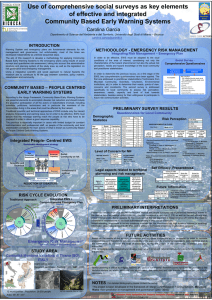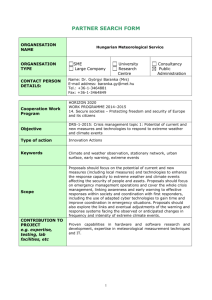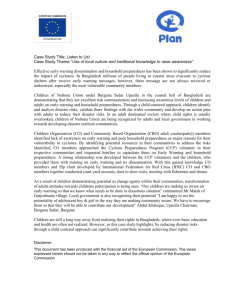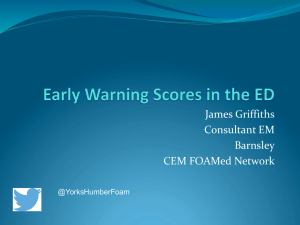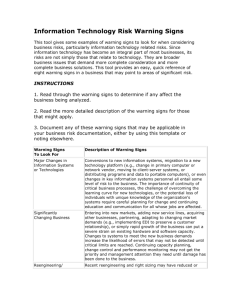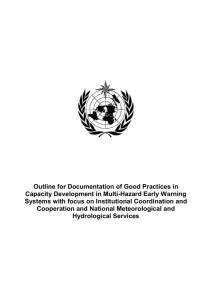doc - WMO
advertisement
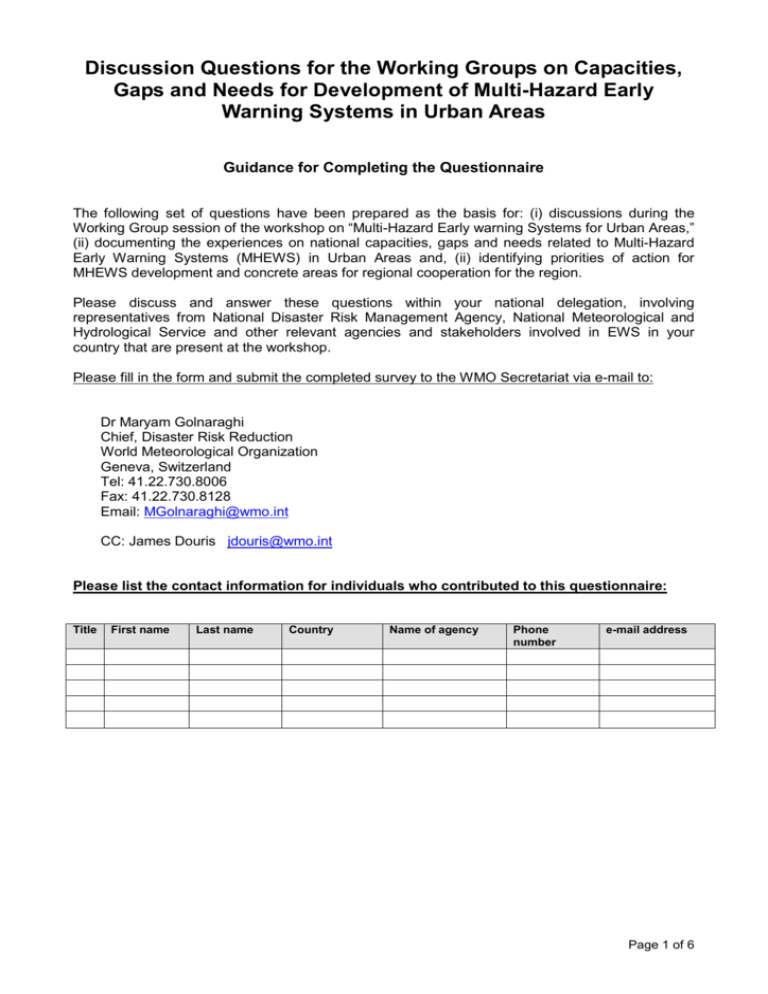
Discussion Questions for the Working Groups on Capacities, Gaps and Needs for Development of Multi-Hazard Early Warning Systems in Urban Areas Guidance for Completing the Questionnaire The following set of questions have been prepared as the basis for: (i) discussions during the Working Group session of the workshop on “Multi-Hazard Early warning Systems for Urban Areas,” (ii) documenting the experiences on national capacities, gaps and needs related to Multi-Hazard Early Warning Systems (MHEWS) in Urban Areas and, (ii) identifying priorities of action for MHEWS development and concrete areas for regional cooperation for the region. Please discuss and answer these questions within your national delegation, involving representatives from National Disaster Risk Management Agency, National Meteorological and Hydrological Service and other relevant agencies and stakeholders involved in EWS in your country that are present at the workshop. Please fill in the form and submit the completed survey to the WMO Secretariat via e-mail to: Dr Maryam Golnaraghi Chief, Disaster Risk Reduction World Meteorological Organization Geneva, Switzerland Tel: 41.22.730.8006 Fax: 41.22.730.8128 Email: MGolnaraghi@wmo.int CC: James Douris jdouris@wmo.int Please list the contact information for individuals who contributed to this questionnaire: Title First name Last name Country Name of agency Phone number e-mail address Page 1 of 6 1 Characteristics of Urban Areas in your country 1.1 Please identify major urban areas in your country, provide information about size (population, area of coverage, location) and types of hazards posing risks, any information about history of impacts of meteorological, hydrological and climate-related hazards. 1.2 For each city urban area you have identified, is there currently an operational early warning system in place? If yes for which hazards? Answer: 2 Governance and Institutional Arrangements 2.1 Please describe the policy, institutional and legal frameworks that support emergency preparedness and response planning (at national level, at municipal level and at city level). Answer: 2.2 Describe the institutional process of emergency preparedness and response planning at national to city levels and who are the key authorities responsible for development of emergency plans and their activation? Do all the identified priority cities have developed local emergency plans? Have these been implemented? Answer: 2.3 Describe the process of in which the National Meteorological and Hydrological Service (NMHS) support the provision of early warning and meteorological and hydrological services to support emergency planning and preparedness in the urban areas? I Answer: 2.4 Please, provide: A list of agencies that are responsible for management and implementation of different components of early warning systems in the urban areas, An organizational chart of the EWS linking national, municipal and local agencies and, An organizational decision-making diagram, showing roles and responsibilities of different Page 2 of 6 agencies at different levels, local, municipal and national, including the NMHS. Answer: 2.5 Give a brief description of how your early warning system works operationally nationally and how it is supported by agencies at different levels of the government. In this context, identify the working relationships among agencies listed in 2.4 above. Answer: 2.6 Describe how the different components of the early warning system are financed for urban EWS development. Are there dedicated financial resources for maintenance and sustainability of the system (e.g. observing networks, communication systems, emergency response, etc.) Answer: 3 Utilization of risk information in emergency planning and warnings at the city level Is hazard-risk information utilized in emergency preparedness and response planning? If yes, please describe how and who is responsible for what? Do you have national to local hazard-risk maps, for what risks? Answer: 4 Hazard monitoring, forecasting, and mandates for warning development at the city level For which natural hazards (see Annex I for a list of Natural Hazards), the National Meteorological and Hydrological Service - has sole mandate for the development of the warning for the hazard (Type I Hazard); - has joint mandate with other agency(ies) for the development of the warning for the hazard (Type II Hazard); - provides information to other agencies that have the mandate for the development of the warning for the hazard (Type III Hazard). Please note that: A reference list of hazards is provided at the end of this text, Are there challenges for institutional coordination for the development of the warnings at the city level? If “yes”, please describe the challenges and how they are addressed. Answer: 5 Warning dissemination mechanisms (linking national to local levels) Specify the dissemination mechanism(s) for delivery of warnings to the authorities and the public at risk in the urban areas? Who is involved in this dissemination mechanism(s)? How do you assess the effectiveness of the dissemination mechanism(s) to ensure that the Page 3 of 6 warnings reached their target audiences in a timely manner? Answer: 6 Emergency preparedness and response activities (national to local) Describe the national to city-level emergency plans and response procedures. Are warning levels used in your early warning system? Who determines them? How are these levels linked to emergency preparedness and response decisions and actions at national to local levels? Answer: 7 Improvement of overall operational framework of the early warning system Please identify and describe evaluation and feedback mechanisms within the operational early warning system that help to improve: - The system as a whole linking city, municipal and national levels. - Products and services provided by the National Meteorological and Hydrological Service to disaster risk management agencies and other stakeholders. - Operational coordination mechanisms of the disaster risk management stakeholders with the National Meteorological and Hydrological Services. Has there been specific disaster(s) or hazard event(s) that has lead to a significant re-evaluation and improvement of your EWS? If yes, please specify and elaborate. Answer: 8 Please provide example of events where your EWS at the national levels had saved lives and explain how. Answer: 9 Which of the following areas are your priorities for the improvement of your EWS? Please elaborate. Governance and Institutional Arrangements national to local levels Utilization of risk information in emergency planning and warnings at the city level Hazard monitoring, forecasting, and mandates for warning development at the city level Warning dissemination mechanisms at the city level benefiting from information provided by national agencies such as NMHS Emergency preparedness and response activities (national to local) Coordination among agencies at the national level and cooperation with local authorities and governments Page 4 of 6 Answer: 10 Provide concrete areas of regional cooperation which could benefit your country’s early warning system in urban and rural settings? Sharing of good practices and expertise (policy, legal framework, institutional cooperation and operational systems Improved technical cooperation, data sharing and exchanging expertise Education and training at management, technical and operational levels Etc. Answer: Page 5 of 6 Annex I: Hazards list Tornado (rotational high winds) Flash flood Strong winds Hailstorm Thunderstorm or lightning Heavy snow Freezing rain Dense fog Tropical cyclone Storm surge Coastal flooding Heat wave: period of abnormally high temperatures Cold wave: period of abnormally low temperatures Drought River flooding Marine hazards (storm, sea ice, icebergs, etc.) Sandstorm Landslide or mudslide Airborne hazardous substances (i.e., nuclear, biological, chemical, etc.) Waterborne hazards (i.e., nuclear, biological, chemical, oil spills, etc.) Desert locust swarm Hydrometeorological hazards to aviation (i.e., turbulence, icing) Avalanche Forest or wild land fire Smoke, Dust or Haze Earthquakes Tsunami Volcanic events Others, please specify Page 6 of 6
